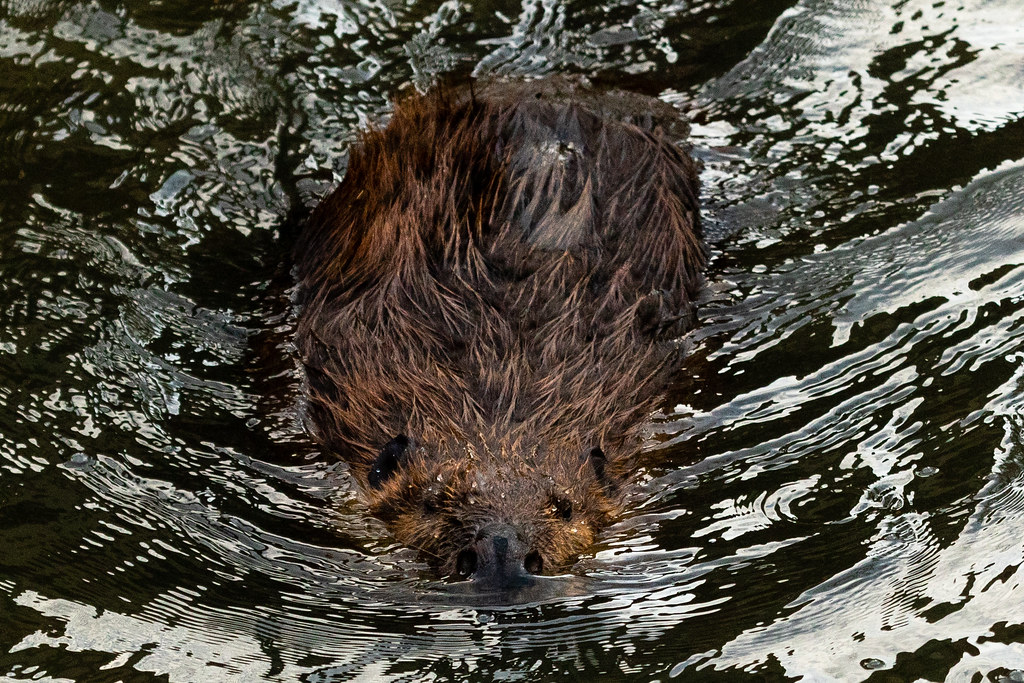Beaver
Castor canadensis
The beaver is a large, brown, semi-aquatic mammal with a distinctive flattened, paddle-like tail. It lives in lakes, streams and forested wetlands throughout the Chesapeake Bay watershed.
This section shows one large critter image at a time. Use the thumbnails that follow to select a specific image to display here.

This gallery contains a grid of small thumbnails. Selecting a thumbnail will change the main image in the preceding section.
Appearance
Beavers have thick, glossy brown fur and a large, scaly, paddle-like tail that can be 9 to 10 inches long and 6 inches wide. They have webbed feet and large front teeth. Their head is round with small, rounded ears. The beaver's head and body grow to 25 to 30 inches long and usually weighs 30 to 60 pounds.
Feeding
Beavers eat mostly tree bark and leaves. Red maples, willows, alders, shadbush and redosier dogwoods are some of their favorite foods. They have specialized digestive tracts that allow them to digest tree bark.
They also eat bay grasses, such as pondweeds, and the roots and rhizomes of aquatic plants, such as lilies and sedges. They store branches and stems in their lodges to eat during winter.
Predators
Adults have few predators; humans hunt beavers for their fur. Owls, hawks and otters may prey upon young.
Voice
Beavers communicate with each other via distinct whining, grunts, grumbles, and barks.
Reproduction and life cycle
Beavers live in colonies that include an adult male and female and their young. Each colony of beavers has only one breeding female. Adult pairs are monogamous, keeping the same mate for life. Adults begin breeding between 2 to 3 years old and have one litter per year.
Mating occurs in January and February. After four months, an average of 2 to 4 young (called kits) are born, covered in thick fur, weighing about one pound and having open eyes. Kits can swim within a week of birth and are weaned within 2 to 3 months. When they are two years old, yearlings (young born the previous spring) are driven out or leave their lodge. Beavers can live 11 years in the wild.
Did you know?
- Beavers are the largest rodent in North America.
- Their large front teeth continue to grow throughout their lives. Beavers are able to close their mouths behind their front teeth so they can carry logs and sticks underwater.
- A beaver builds lodges of sticks and mud on islands, river banks and shorelines. They can chew down a small tree in just a few minutes to eat or to repair their dams and lodges.
- To protect their lodges, beavers build dams across streams to flood the area and create deep, quiet ponds. These ponds allow beavers to safely transport food and logs through the water. Ponds formed by beaver dams are important habitat for fish and waterfowl
- Their webbed feet and rudder-like tail allow beavers to swim about six miles per hour. Their large tails make a loud sound when a beaver dives underwater.
- Beavers can be confused with muskrats and nutria. Beavers are the largest of the three animals and have distinctive flattened paddle-like tails.
- Once treasured for their fur, which was used as a wind- and rain-proof fabric for hats, beaver populations were depleted until just a few pockets remained. In the early 1900s, hunting and logging regulations were put in place to help beavers recover.
Sources and additional information
- Chesapeake Bay: Nature of the Estuary, A Field Guide by Christopher P. White
- Wildlife Information: Beaver – Virginia Department of Game & Inland Fisheries
- Living With Beaver – Howard County, Maryland Department of Recreation & Parks
- Animal Diversity Web: Castor canadensis – University of Michigan Museum of Zoology
- North American Mammals: Castor canadensis – Smithsonian National Museum of Natural History
- Index of Species Information: Castor canadensis – U.S. Forest Service
- NatureWorks: Beaver – New Hampshire Public Television
